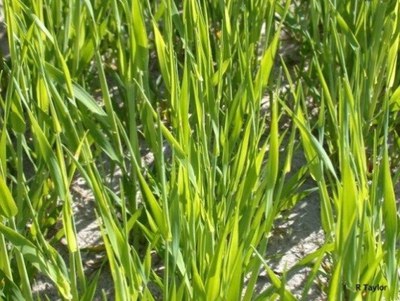Is sulfur deficiency in spring wheat a concern in North Dakota?
Sulfur (S) is vital for wheat grain yield and quality but is not needed in high amounts as in alfalfa and canola. Higher yielding crops will require more S.

Deficiency symptoms: Young leaves and sometimes whole plants are light green to yellow because S is immobile and is not transferred from older to younger leaves (Figure 1. S deficiency in wheat; photo courtesy: R. Taylor); retarded and stunted growth with spindly stalks.
Conditions that may cause S deficiency: Wheat is more likely to respond to S fertilizer in coarse texture soils with low SOM (<3%) content and on eroded soils. Sulfur deficiency is likely in cooler than normal spring temperatures especially on no-till fields. Poor drainage and ponded soil reduce conversion of organic S (the main source of soil S) to the available sulfate form. High fall and spring precipitation can cause leaching of available S below root depths.
Is it economical to apply S to wheat? More often than not, S application has improved yields significantly in sandy soils but limited economic benefits in non-sandy soils. Mineralization of S from adequate SOM levels and high gypsum in North Dakota soils often meet plant needs. Between 20 and 30 lbs. of S is adequate to meet wheat S demands. Extensive research shows that wheat yields and grain quality improve when S is applied in non-limiting soil N. Nitrogen use efficiency increases with adequate S. When in doubt, apply an insurance rate of about 10 lbs. of readily available S as ammonium sulfate (21-0-0-24S). Sulfur deficiency would hurt grain yields significantly. In a Carrington N study, S deficiency was partly responsible for lack of yield response to N rates (with yield decline) at N > 60lbs (Figure 2).
Reliability of S soil test: Soil S test is not a reliable predictor of wheat response but may help indicate soil S status. Plant tissue analysis is a useful tool to detect S problems. Sample leaves from suspected areas in the field and from more vigorous looking plants. Send plant samples to the NDSU laboratory for N and S analysis. The tissue N:S ratio is an important indicator of S needs by wheat. Tissue N:S ratio > 16 - 20 may suggest insufficient plant S. Sulfur analysis alone may not give you all the information needed to determine S fertilizer needs. At time of plant sampling, collect a composite soil sample from respective plant sampling areas for S analysis.
Jasper M. Teboh
Soil Scientist


